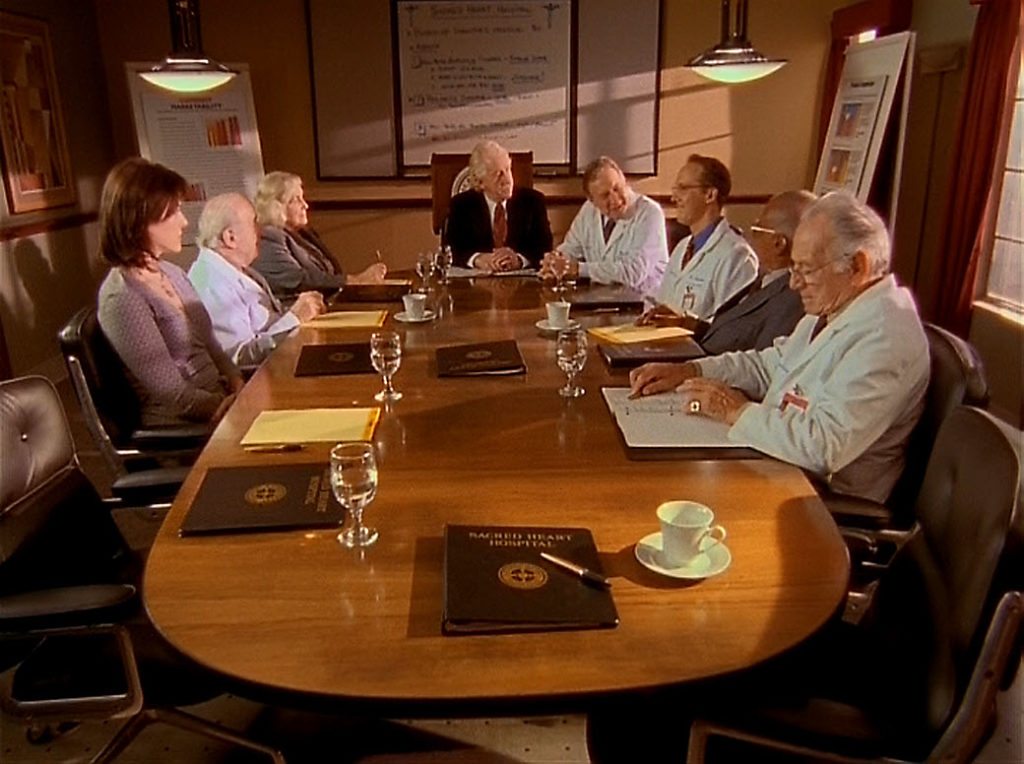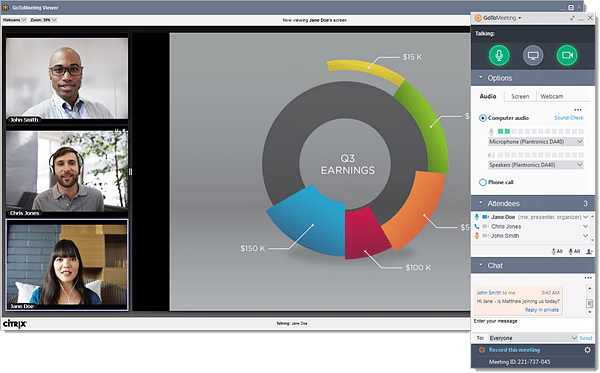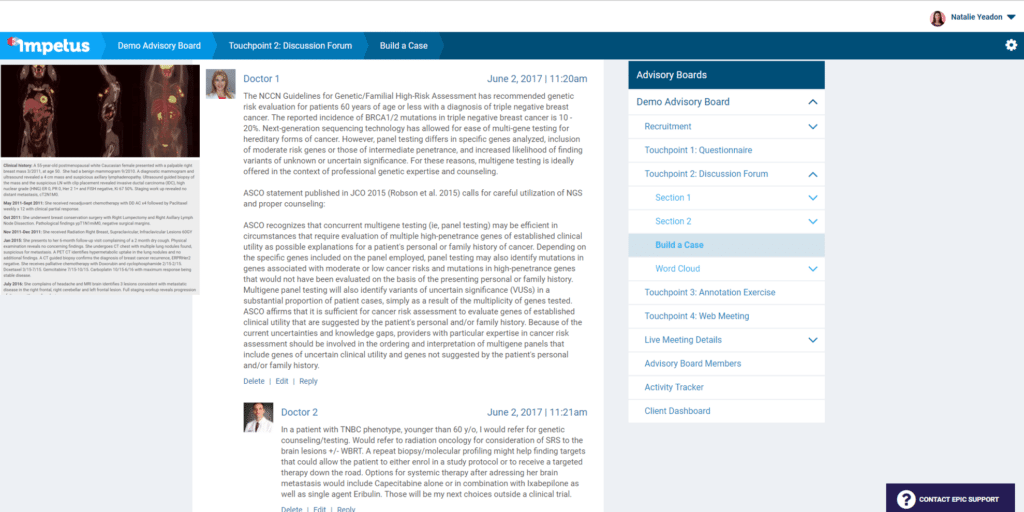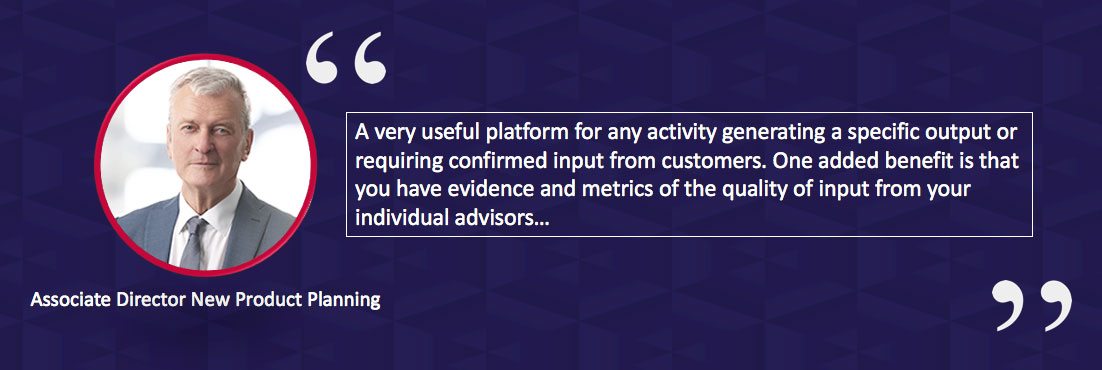In my recent post entitled “Step 3: How to select your best customers and resources” published on May 16, 2017, I discussed the third step in our MIQ Discovery™ process when developing a Longitudinal Expert Engagement Plan with your advisors. It is comprised of deciding which of your customers in your stakeholder universe will be key in helping you to achieve your success metrics for the issues and objectives you have laid out through Steps 1 and 2. It also focused on what data sources should be leveraged for that particular target audience and how that information should be gathered, framed and presented.
Once you have mapped out your overall key opinion leader strategy and engagement plan outlining the issues to be solved, the metrics for success, the customers you will be targeting and the data you will be engaging them with, the next step is to determine what channels will be best suited to help gather the insights you are seeking. At Impetus Digital, we provide 3 specific methods to assist our clients in engaging with their customers. The 3 touchpoint modalities we employ are: in-person meetings, web meetings, and asynchronous online touchpoints.
Synchronous Touchpoints: In-Person Meetings
In-person meetings are the tried and tested way in which most pharmaceutical companies have engaged with advisors and steering committee members. This is the historical norm and brand plans and budgets have always included the costs associated with this traditional communication modality. In fact, in most companies, when somebody mentions the word “advisory board”, they are usually conjuring up an image of a group of customers gathered around a board table for anywhere between 4-8 hours in a meeting room.
 There are many reasons why brands choose to engage their customers using in-person meeting touchpoints. Firstly, pharmaceutical companies have their commercial roots firmly embedded in the large sales force model. Historically, when physicians were the key decision makers, sales reps were utilized to inform and educate prescribers about their product’s benefits for their patients. In-person sales calls were very effective and helped propel product sales from launch throughout the product’s full life cycle before loss of exclusivity. The connection was made that relationships, connections and the trust that ensued were keys in getting products prescribed. This belief carried forward in all other marketing strategies, even if they were considered “non personal” promotional activities. The number one priority for companies has been to build relationships with customers as they see it as the only effective way to truly connect. In addition, consultancy meetings have traditionally been used as an alternative “sales” channel in which brand ideas, plans and data are discussed in corporate board rooms and simply brought in front of boards for “buy-in”.
There are many reasons why brands choose to engage their customers using in-person meeting touchpoints. Firstly, pharmaceutical companies have their commercial roots firmly embedded in the large sales force model. Historically, when physicians were the key decision makers, sales reps were utilized to inform and educate prescribers about their product’s benefits for their patients. In-person sales calls were very effective and helped propel product sales from launch throughout the product’s full life cycle before loss of exclusivity. The connection was made that relationships, connections and the trust that ensued were keys in getting products prescribed. This belief carried forward in all other marketing strategies, even if they were considered “non personal” promotional activities. The number one priority for companies has been to build relationships with customers as they see it as the only effective way to truly connect. In addition, consultancy meetings have traditionally been used as an alternative “sales” channel in which brand ideas, plans and data are discussed in corporate board rooms and simply brought in front of boards for “buy-in”.
In today’s environment, connecting in person has become increasingly difficult. Legislation, compliance and institutional regulations and disclosure requirements have deterred healthcare providers in meeting with sales reps and attending pharmaceutical sponsored events and programs. In addition, because time pressed physicians are expected to produce more with less time in order to meet financial targets, key opinion leaders have fewer hours available to consult with companies. In the uber-competitive pharmaceutical marketplace where hundreds of products are vying for attention with minimal points of differentiation, physicians are being asked to consult on more boards than time will allow. They can no longer fly from city to city to attend half or full day meetings.
 In addition, pharmaceutical companies are finding that traditional marketing budgets are getting slashed. In a more risk averse environment where compliance rules, promotional efforts are thwarted and greater levels of transparency are expected, less money is being funneled into sales and marketing. Manufacturers are also struggling to maintain growth targets and address shareholder expectations with dwindling pipelines and less than stellar revenue projections for products that are not first in class. Pharma marketers, however, are still be asked to engage in the same activities but are now faced with the dilemma of targeting a much broader and more complex stakeholder base. With new decision makers thrown into the mix such as allied healthcare providers, hospital administrators, payers and patients, the question on how to meet with everyone in person to drive the business becomes even more pervasive.
In addition, pharmaceutical companies are finding that traditional marketing budgets are getting slashed. In a more risk averse environment where compliance rules, promotional efforts are thwarted and greater levels of transparency are expected, less money is being funneled into sales and marketing. Manufacturers are also struggling to maintain growth targets and address shareholder expectations with dwindling pipelines and less than stellar revenue projections for products that are not first in class. Pharma marketers, however, are still be asked to engage in the same activities but are now faced with the dilemma of targeting a much broader and more complex stakeholder base. With new decision makers thrown into the mix such as allied healthcare providers, hospital administrators, payers and patients, the question on how to meet with everyone in person to drive the business becomes even more pervasive.
Although in person consultancy meetings can be excellent in terms of relationship building and capturing advisors’ initial impressions on data and new information, they are not the best from an overall “engagement” metric standpoint. On average, we have evaluated over the past 6 years in our experience with planning in person meetings, that from the original roster of invitees, only about 60% are able to attend live meetings. Marketers are often compelled, as a result, to invite other “second tier” advisors in order to bolster their meeting attendee numbers. In addition, since most medical professionals are considered “analyticals” and require time to process new information, presenting brand new data during an in person meeting can often result in “knee-jerk” reactions from the attendees. Based on team dynamics and the psychology of body language and personality types, “verbose” advisors can often outshine the more introspective attendees who may not choose to speak up as often, if at all. As a result, in person meeting touchpoints may not always result in the most comprehensive inclusion of everyone’s opinions on specific issues, no matter how well meetings are facilitated.
Synchronous Touchpoints: Web Meetings
Often, when marketing teams are challenged to think more innovatively about how they are approaching their business and asked to incorporate digital into their plans, there is a tendency to immediately gravitate towards web meeting touchpoints as the perceived “best” alternative to the in person meeting. After all, it is “digital” and is therefore more cutting edge. It also enables marketers and medical managers to maintain their belief that synchronous connection via a web meeting will help them to initiate, build and sustain relationships with their customers because they can actually “see” and “speak” with them real time.
 Web meetings touchpoints are no doubt an excellent replacement or augmenter of the traditional in person meeting. Firstly, they are less expensive and do not require companies to spend money on logistics such as flights, hotels, meeting rooms, food and AV equipment. Secondly, because everyone can attend from any location in the world, it improves the overall attendance rate. We find, on average, of those customers listed on the original roster of invitees, approximately 70% are able to attend. It is slightly better than the in person meeting statistics, however, attendance can still be thwarted by the fact that invitees are required to be available at the exact same time. Due to schedule conflicts, being available synchronously is not always possible.
Web meetings touchpoints are no doubt an excellent replacement or augmenter of the traditional in person meeting. Firstly, they are less expensive and do not require companies to spend money on logistics such as flights, hotels, meeting rooms, food and AV equipment. Secondly, because everyone can attend from any location in the world, it improves the overall attendance rate. We find, on average, of those customers listed on the original roster of invitees, approximately 70% are able to attend. It is slightly better than the in person meeting statistics, however, attendance can still be thwarted by the fact that invitees are required to be available at the exact same time. Due to schedule conflicts, being available synchronously is not always possible.
Web meetings can be effective if used to truly leverage the attendees for their feedback and to engage in discussions. Impetus has several examples of how we facilitate this which I will share in a future blog. We sometimes find that companies will still leverage web meetings as type of “educational” forum where they will ask an  international speaker to share new data by presenting slides and then opening up the web meeting at the end for questions. In these scenarios, customers are not being actively engaged or asked for their opinions so we can see, through our assessment tools, loss of attention and views of the screen where the slides are being shown. Because advisors are muted during web meeting presentations, you can often lose people to other tasks such as checking email or even washing the dishes if they happen to be attending from home.
international speaker to share new data by presenting slides and then opening up the web meeting at the end for questions. In these scenarios, customers are not being actively engaged or asked for their opinions so we can see, through our assessment tools, loss of attention and views of the screen where the slides are being shown. Because advisors are muted during web meeting presentations, you can often lose people to other tasks such as checking email or even washing the dishes if they happen to be attending from home.
Finally, the right web meeting technology needs to be employed to make this type of communication effective. Advisors are often attending web meeting touchpoints from hospital environments, so the platform used needs to be able to bypass fairly stringent firewalls. The same applies if the platform used requires the advisors to download or install something onto their work computer, which is often employing old technologies or browsers. Many healthcare providers are not very tech savvy and can get lost on where to click and what needs to be opened on their computer. Simple and intuitive web meeting technology that is expertly hosted and supported for technical issues by an experienced vendor needs to be an integral part of the web meeting strategy.
Asynchronous Online Assignments
Relationships, which are the driving force behind the continuous support of traditional in person and web meetings, can surprisingly be developed just as effectively online. Online relationships have a much more “transparent” stance to them and, with the new physician demographic to consider, is actually expected. Information is everywhere and free for the asking. Having manufacturers engaging with their advisors in a more authentic way by “partnering” and not just “selling” or “educating” is the way forward in successfully building brand advocacy and support by prescribers and other stakeholders in the new environment in which we work. Partnering and developing authenticity requires communication agility, responsiveness and consistent interactions over time and not just one-off interactions that may only occur once a year. To enable this level of communication, alternative channels outside of in person meetings need to be employed. Enter the era of digital.
 Physicians and most healthcare providers are surrounded by computers and many are referring to smart phones or tablets during their normal daily workflow. Texting, private online communities and other digital communication channels have become the norm on how healthcare stakeholders share information and collaborate. It is fast, effective and doesn’t require a lot of time and effort. We even see this in our own personal relationships. Meeting up for coffee or even calling people on the phone has become, to a large degree, obsolete. We meet people online all the time. In fact, some people can derive real personal connection to others they have only met virtually by sharing authentically in online forums and other digital spaces where there are shared interests in common. With all of this in mind, we have observed for ourselves some companies building relationships with their customers using a series of online touchpoints with absolutely no in person meetings at all! Developing relationships through virtual interactions IS possible and contradicts the ingrained belief that new product launches, regardless of the specialty or the size of the physician community, MUST be accompanied by a series of in person contact points.
Physicians and most healthcare providers are surrounded by computers and many are referring to smart phones or tablets during their normal daily workflow. Texting, private online communities and other digital communication channels have become the norm on how healthcare stakeholders share information and collaborate. It is fast, effective and doesn’t require a lot of time and effort. We even see this in our own personal relationships. Meeting up for coffee or even calling people on the phone has become, to a large degree, obsolete. We meet people online all the time. In fact, some people can derive real personal connection to others they have only met virtually by sharing authentically in online forums and other digital spaces where there are shared interests in common. With all of this in mind, we have observed for ourselves some companies building relationships with their customers using a series of online touchpoints with absolutely no in person meetings at all! Developing relationships through virtual interactions IS possible and contradicts the ingrained belief that new product launches, regardless of the specialty or the size of the physician community, MUST be accompanied by a series of in person contact points.
Physicians today are looking for authentic connections, regardless if the company is a known entity or not, large or small or new or experienced in the therapeutic area being discussed. They want to be able to have their questions answered quickly. They want to partner with companies but would prefer easier and more convenient ways in which to do so. By leveraging secure, compliant, password protected online portals, such as the Impetus InSite Platform, where “call to action” asynchronous assignments are available, physicians can log in at any time and on any device over a certain period of time. The opportunity for peer learning, moderation and replying and reacting to colleague’s comments without the requirement of everyone being available at the same location or at the same time can guarantee companies over 90% engagement rates with these sorts of assignment touchpoints. In addition, the ability for physicians to ruminate on digestible pieces of information over a course of time only cements understanding and facilitates the flow of thinking that results in more granular and well thought through responses. In addition, the typical 10 question asynchronous online touchpoint results, on average, in approximately 30 pages of transcript while a typical in person consultancy meeting with result in about 15 pages–a difference of almost 50%! Also, the speed in which to turn around an online assignment, should there be an occurrence in the market that needs to be addressed immediately, can be increased by 40%. Finally, for the same cost of an in person meeting, companies can reach 3X the number of customers or 4X the frequency with the same customer group.
 There are pros and cons to any channel or modality and careful consideration needs to be made on the objectives of the interactions and the measures of success one wants to achieve. A highly successful customer engagement plan can integrate all three of these modalities at various timepoints throughout the year based on the strategic needs of the brand and the major milestones that need to be addressed.
There are pros and cons to any channel or modality and careful consideration needs to be made on the objectives of the interactions and the measures of success one wants to achieve. A highly successful customer engagement plan can integrate all three of these modalities at various timepoints throughout the year based on the strategic needs of the brand and the major milestones that need to be addressed.


Homework time!
Want to skip ahead? Curious how this actually works?
Sign up for a special complimentary, no obligation, personalized one-on-one web meeting demonstration to see how the MIQ Discovery™ process works, and howour best-in-class collaboration can be leveraged for your next advisory board or steering committee.


